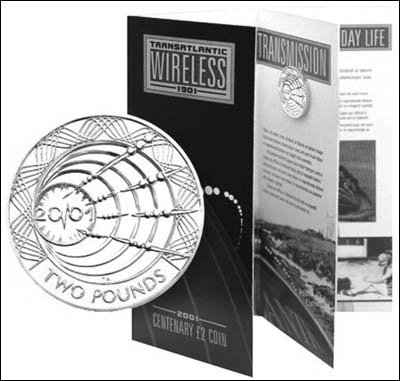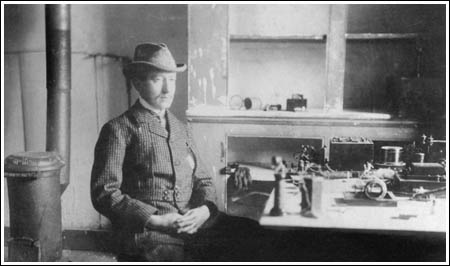Of Old Radios And Related Items--Published Monthly
British Coin Commemorates
Marconi CentennialBY MICHAEL DALZELL
Web Edition
Once in a rare while, two collecting passions become one. In the following article, Mike Dalzell, brings his interest in coin and radio collecting together with a great moment in communications history -- Marconi's first transatlantic transmission in December 1901, the anniversary of which we celebrate in this issue. (Editor)

The uncirculated, nickel-brass £2 Marconi commemorative coin, shown with its presentation folder. It is available for $9.95 U. S.
On a raw Canadian Maritime morning, the scientist was in the mood to fly a kite. It wasn't recreation that drove the man; rather, he burned to prove that electromagnetic waves sent through the air were unaffected by the curvature of the earth. The white bedsheet that Guglielmo Marconi sent skyward that December morning in 1901 carried an aerial wire extending to the ground, which he would soon use to sense signals beamed from almost half a planet away.
This test flight at St. John's, Newfoundland, on December 10 was a success, setting the stage for Marconi's grand experiment. Across the Atlantic Ocean, engineers at a station Marconi had built the previous year were given the go-ahead to transmit the Morse letter "S" for three hours a day -- from 1 to 3 a.m., and noon to 1 p.m. On December 11, signals began to emanate from the station in Poldhu, England, on the Cornwall peninsula. Shortly after 12:30 p.m.. on December 12, Marconi heard through his headphones a weak but unmistakable dit-dit-dit telegraphic signal "S." Communication would never be the same.
To recognize the centennial of the occasion, the British Royal Mint issued on October 15, 2001, a special £2 commemorative coin that is certain to appeal to radio enthusiasts and numismatists alike. The bimetallic coin is composed of a golden-colored outer ring and silver-colored insert, and is minted in gold, silver, and nickel-brass versions.
As on all British coins, the front of this coin depicts the Queen in the portrait by Ian Rank-Broadley. Around the edge is the inscription, "Wireless Bridges the Atlantic...Marconi 1901..." American readers may find it interesting that the guidelines for reproducing coins of the United Kingdom prohibit showing the side with the Queen's likeness.
The reverse side of this coin features a stylized series of telegraphic symbols for the letter "S" that beam from a spark of electricity linking the zeros in the date 2001. Radiating waves overlap the symbols. Around the edge of the coin are more wireless waves.
In striking this coin, the Royal Mint broke with tradition by allowing the public -- for the first time -- to choose the design. More than 13,000 readers of Radio Times, as well as customers on the mint's mailing list and visitors to its Web site, were asked to vote for their favorite of three designs: one depicting the sending and receiving of radio waves across a curved ocean, one with Marconi's face superimposed over a map of the North Atlantic, and a third -- the eventual winning design by Royal Mint engraver Robert Evans -- graced by the telegraphic "S's."
Crowning achievement
Evans's conceptualization of the moment is as forceful as was Marconi's will to demonstrate that electromagnetic signals could be transmitted over long distances. In 1894, just seven years before his transatlantic achievement, Marconi had been the first to suppose that Hertzian waves could be used to communicate.
Fascinated by the work of Maxwell, Hertz, and Lodge, the 20-year-old Marconi built on their theories, constructed his first crude radios, and sent signals from a window in his Italian granary to the end of his garden -- about 100 meters -- where a farmer waved a handkerchief to indicate the signal had been received. A year later, in 1895, Marconi transmitted a signal over a hill (an obstacle that experts said would kill the signal) to a receiver two miles away -- a moment considered as the birth of wireless communication.
In 1896, the Italian government turned up its nose at Marconi's now-patented system as "not suitable for telecommunications." However, his mother recognized the importance of her son's invention. Through her cousin, Londoner David Jameson, Marconi was able to secure financial backing (as well as the world's first wireless-telegraphy patent) from the British government. By 1898, Marconi had improved his equipment and succeeded in sending a signal across the English channel, though most scientists of the day still dismissed his notion of using wireless for long-distance communication.
In October 1900, Marconi completed his transmitting station at Poldhu in Cornwall. Early the next year, he began constructing a receiving station on Cape Cod, but an autumn northeaster blew the station apart. Marconi traveled farther north, to St. John's, Newfoundland, where he landed November 26 and hastily prepared to complete his experiment. Without time to build a proper receiving station, Marconi improvised. The airborne kites served his purpose, floating high enough to pick the signals from Poldhu out of the air.

Marconi pictured at Signal Hill, Newfoundland, just after receiving the first wireless signal to cross the Atlantic on December 12, 1901. It consisted of the Morse code letter "S" (dit-dit-dit) transmitted from his wireless station at Poldhu, Cornwall. (From Bussey's "Marconi's Atlantic Leap.")
And what did he get for his trouble? Marconi was promptly driven out of Newfoundland by cable companies that claimed a monopoly on transatlantic communication. The next year, Marconi was invited by the Canadian government to set up a sending-and-receiving station in Glace Bay, Nova Scotia. By December, he had succeeded in sending and receiving messages from west to east -- making 2-way transatlantic communication possible. Marconi was awarded the Nobel prize for physics in 1909.
Coin options
The nickel-brass Marconi coin ($9.95) makes a fun gift idea for yourself or someone else who appreciates the early history of radio. It is mounted in a pictorial presentation folder that tells the story of his historic event in 1901.
The sterling silver version ($47.95), features a 22-karat-gold-plated outer ring and is limited to a mintage of 25,000. This mintage is extremely rare by modern standards; for example, in 2000, the Royal Mint coined 31 million circulating £2 coins.
The gold version is composed of a yellow-gold band. Its $550 price tag bespeaks its rarity (2,500 coins).
The coins are available from the British Royal Mint. Telephone: 800-221-1215 or at www.royalmint.com on the Web. With the gold coin, the Royal Mint offers Gordon Bussey's hardcover book Marconi's Atlantic Leap. The book is available separately at amazon.co.uk for $10.95 U. S. Bussey, consultant historian for Marconi PLC, briefed the three artists and inspired their sketches for the coin design contest.
The £2 piece is a lasting tribute to a man whose vision sparked the most profound revolution in communication since the printing press and until the development of the Internet.
(Michael Dalzell, 5073 Winfield Court, Bensalem, PA 19020)
Michael Dalzell, a former radio journalist, is now the managing editor of "Managed Care" magazine. He caught the old-radio bug in 1973 when, at the age of 10, he discovered his grandfather's Hallicrafters Sky Buddy in the basement. He began actively collecting antique radios in 1987. He also has collected coins since 1971.
References:
"BRM Deviates From Tradition." Coin World. June 4, 2001, p. 70.
British Royal Mint. Annual Report: 2001. Available at www.royalmint.com.
British Royal Mint. Chronicle 79 and Chronicle 80. 2001.
Bussey, Gordon. Marconi's Atlantic Leap. Coventry, England: Marconi Communications, 2001. Available at amazon.co.uk.
Craig, Joe. "The First Transatlantic Wireless Signal." The Canadian Amateur. December 1996. Available at www.ucs.mun.ca/~jcraig.marconi.html.
"1895: Marconi's Invention," and "A Signal Crosses the Atlantic." Available at www.alpcom.it/hamradio.
"Guglielmo Marconi -- Biography." The Nobel Foundation. Available at www.nobel.se/physics/laureates/1909/marconi-bio.html.
"Radio Signals Across the Atlantic!" Available at www.parkscanada.pch.gc.ca/library/stories/displayliste.cfm?id=48.
| [Free Sample] [Books, etc., For Sale] [Subscribe to A.R.C./Renew] [Classified Ads] [Auction Prices] [Event Calendar] [Links] [Home] [Issue Archives] [Book Reviews] [Subscription Information] [A.R.C. FAQ] URL = http://www.antiqueradio.com/Dec01_marconi-coin.html Copyright © 1996-2001 by John V. Terrey - For personal use only. Last revised: November 23, 2001. For Customer Assistance please contact ARC@antiqueradio.com or call (866) 371-0512 Pages designed/maintained by Wayward Fluffy Publications
Antique Radio Classified |